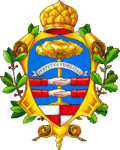Difference between revisions of "Pesaro"
m |
m |
||
| Line 1: | Line 1: | ||
__NOEDITSECTION__ | __NOEDITSECTION__ | ||
| − | [[Image:Pesaro-Stemma.png|120px]] | + | [[Image:Pesaro-Stemma.png|120px|right]] |
city = Comune di Pesaro| | city = Comune di Pesaro| | ||
name = Pesaro| | name = Pesaro| | ||
Revision as of 10:54, 3 July 2007
city = Comune di Pesaro| name = Pesaro| region = Marche | province = Pesaro e Urbino (PU) | altitude = 11| area_cityproper = 126| population_as_of = December 31, 2004| populationdensity = 91,983| populationdensitymetric = 717| timezone = CET, UTC+1 | frazioni = Santa Veneranda| telephone = 0721| postalcode = 61100| gentilic = Pesaresi| saint = St. Terence| day = September 24| mayor = Luca Ceriscioli | website = www.comune.pesaro.ps.it | mapx = 43.89| mapy=12.9|
Pesaro is a town and comune in the Italian region of the Marche, capital of the Pesaro e Urbino province, on the Adriatic. According to the 2003 census, its population was 91,400.
Fishery, furniture industry and tourism are the main points in the local economy.
History
Template:Sect-stub The city was founded as Pisaurum by the Romans in 184 BC as colony in the territory of the Piceni, the people who lived in the Marche during the Iron Age. A settlement of the latter tribe, one of their most ancient, has been found at Novilara. The northern Piceni were invaded in the 4th century BC by the Senones Gauls, and when the Romans reached the area the population was a mix of the two races.
Under the Roman administration Pesaro, a hub across the Via Flaminia, became an important center of trading and craftmanship. After the fall of the Western Empire, Pesaro was occupied by the Ostrogoths, and destroyed by Vitigis (539) in the course of the Gothic War. Hastily rebuilt five years later after the Byzantine reconquets, it formed the so-called Pentapolis, part of the Exarchate of Ravenna. After the Lombard and Frank conquests of that city, Pesaro became part of the Papal States.
During Renaissance it was ruled by the Malatesta (1285-1445), Sforza (1445-1512) and Della Rovere (1513-1631). Under the latter family, who elected it as capital of their duchy, Pesaro lived its most flourishing age, with the construction of numerous public and private palaces, while a new line of walls (the Mura Roveresche) was erected.
On December 11, 1860 the Piedmontese troops entered the city, and Pesaro was subsequently annexed to the new Kingdom of Italy.
Main sights
- The Ducal Palace, constructed by Alessandro Sforza in the second half of the 15th century. The façade has a portico with six arcades supported by six heavy pilasters and an upper floor with five windows crowned by coats of arms, festoons and puttoes.
- The Romanesque Cathedral Basilica, built in the 5th century over remains of a late Roman edifice and dedicated to St. Terence during the Middle Ages. The façade, in Romanesque-Gothic style, is unfinished: it has a simple ogival portal surmounted by a band of small archs. A recent restoration has brought to light a precious set of floor mosaics.

- The Baroque Sanctuary of Beata Vergine del Carmelo (18th century).
- St. Augustine, with a splendid Gothic portal.
- The massive Rocca Costanza (Castle), built in the 15th century by Costanzo Sforza, once used as prison. It has a square plan with four cylindrical towers and a wide ditch.
- The birthplace of Gioacchino Rossini located at 34 Via Rossini. It has a museum dedicated to the composer, with manifestoes, prints, portraits and his spinetta.
- The 15-16th century Imperial Villa (Villa Imperiale) stands atop the San Bartolo hill. Its room are decorated by renowned artists, including Bronzino, Francesco Menzocchi, Girolamo Genga, and Raffaellino del Colle.
- Of the 17th century Mura Roveresche ("Della Rovere Walls", demolished in the early 20th century), only two gates, Porta del Ponte, Porta Rimini and a short section remain.
- The Town Museum houses the noteworthy Pesaro Altarpiece by Giambellino. The Oliveriani Museum is home to several interesting archaeological findings.
Culture
- The Pesaro film festival (Mostra Internazionale del Nuovo Cinema) has taken place in Pesaro since 1965.[1]
- Opera composer Gioacchino Rossini was born in Pesaro in 1792. Pesaro is home of the Rossini Opera Festival, which has taken place every summer since 1980.
- Pesaro hosts the home games of Victoria Libertas basketball team, better known across Europe as Scavolini Pesaro.
Sister towns
Pesaro currently has seven sister cities (also known as "twin towns"):
See also
